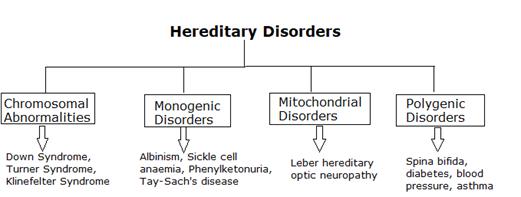Class 9 MAHARASHTRA STATE TEXTBOOK BUREAU Solutions Science Chapter 16 - Heredity and Variation
Heredity and Variation Exercise Exercise
Solution 1
a. Hereditary characters are transferred from parents to offspring by inheritance, hence they are said to be structural and functional units of heredity.
b. Organisms produced by asexual reproduction show minor variations.
c. The component which is in the nuclei of cells and carries the hereditary characteristics is called chromosomes.
d. Chromosomes are mainly made up of DNA.
e. Organisms produced through sexual reproduction show major variations.
Solution 2a
Mendel crossed two pea plants with only pair of contrasting characters. This type of cross is called a monohybrid cross.
Tall pea plants (TT) and dwarf pea plants (tt) were used in this cross. Hence, this is parental generation (P1).
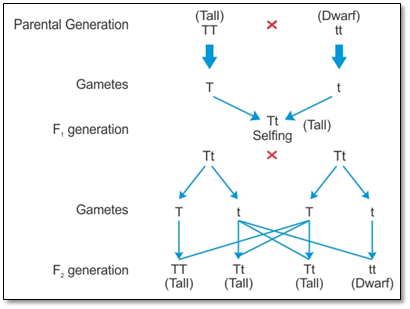
All the plants produced in F1 generation are tall, having genotype Tt. This indicates that the gene responsible for tallness in pea plants is dominant over the gene responsible for dwarfness.
When F1 plants are self-pollinated, they produce second filial generation (F2).
In F2 generation, both tall and dwarf plants appeared in the ratio 3:1.
Thus, the genotypic ratio of F2 generation is 3 (Tall) : 1 (Dwarf) and the genotypic ratio is 1 TT : 2 Tt: 1 tt.
Solution 2b
In a dihybrid cross, Mendel considered two pairs of contrasting characters. He made a cross between a pea plant producing rounded and yellow coloured seeds (RRYY) and a pea plant with wrinkled and green coloured seeds (rryy).
All plants produced in F1 generation had rounded yellow seeds. This is because in pea plants, round shape of seed is dominant over wrinkled shape and yellow colour of seed is dominant over green colour.
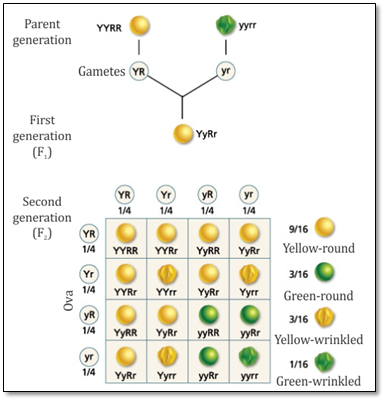
When F1 plants are self-pollinated, they produce four types of gametes - RY, Ry, rY, ry.
F2 plants formed by the fusion of four types of male gametes and four types of female gametes, had phenotypes such as round yellow, wrinkled yellow, round green and wrinkled green.
Also, F2 generation showed nine different types of genotypes such as RRYY, RRYy, RRyy, RrYY, RrYy, Rryy, rrYY, rrYy, rryy.
The phenotypic ratio of a dihybrid cross is 9:3:3:1.
The genotypic ratio of a dihybrid cross is 1:2:1:2:4:2:1:2:1.
Solution 2c
Differences between monohybrid and dihybrid cross:
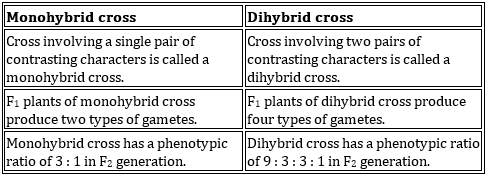
Solution 2d
No, it is not right to avoid living with a person suffering from a genetic disorder. Genetic disorders are transmitted from parents to offspring only and they are non-contagious, i.e., they do not spread from one person to another through contact.
Solution 3a
The structure in the nucleus of cells that carries the hereditary characteristics is called the chromosome. It is made up mainly of nucleic acids and proteins.
Depending on the position of the centromere, there are four types of chromosomes - metacentric, sub-metacentric, acrocentric and telocentric.
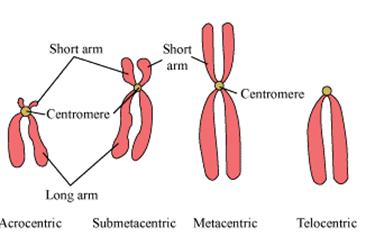
(a) Metacentric: The centromere is exactly at the mid-point in this chromosome, and therefore, it looks like the English letter 'V'. The arms of this chromosome are equal in length.
(b) Sub-metacentric: The centromere is somewhere near the mid-point in this chromosome which, therefore, looks like the English letter 'U. One arm is slightly shorter than the other.
(c) Acrocentric: The centromere is near one end of this chromosome which therefore looks like the English letter 'J'. One arm is much smaller than the other.
(d) Telocentric: The centromere is right at the end of this chromosome making the chromosome look like the English letter 'i'. This chromosome consists of only one arm.
Solution 3b
Structure of DNA
- In 1953, Watson and Crick proposed a model of the DNA molecule.
- As per the model, two parallel threads (strands) of nucleotides are coiled around each other to form a double helix structure. This structure can be compared with a coiled and a flexible ladder.
- Each strand of DNA is made up of many small molecules known as nucleotides.
- Nucleotides are arranged like a chain in the DNA.
- Each nucleotide is made up of a molecule of nitrogen base and phosphoric acid joined to a molecule of sugar.
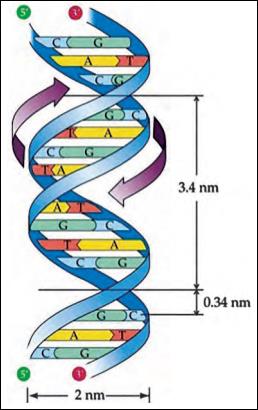
- There are four types of nitrogen bases - adenine, guanine, cytosine and thymine.
- Adenine and guanine are called purines while cytosine and thymine are called pyrimidines.
- The two strands of DNA are comparable to the two rails of the ladder and each rail is made up of alternately joined molecules of sugar and phosphoric acid.
- Each rung of the ladder is a pair of nitrogenous bases joined by hydrogen bonds.
- Adenine always pairs with thymine and cytosine always pairs with guanine.
Solution 3c
- DNA fingerprinting is a technique in which the sequence of genes in the DNA of a person, i.e., the genome of the person is identified.
- This technique is useful to identify the lineage and catch the criminals because DNA is unique to every person.
- It is also useful to settle paternity and maternity disputes.
- DNA fingerprinting technique was developed by Professor Sir Alec Jeffreys.
- A common method of collecting a reference sample is the use of a buccal swab. If this is not available, blood or saliva or hair sample may be used.
- Just like the actual fingerprint, the DNA fingerprint is something that everyone is born with. It is unique to a person.
- DNA fingerprint is very useful in forensic science.
Solution 3d
Structure of RNA
- Ribonucleic acid (RNA) is an important nucleic acid of the cell.
- RNA is made up of ribose sugar, phosphate molecules and four types of nitrogenous bases - adenine, guanine, cytosine and uracil.
- The nucleotide i.e., smallest unit of the chain of RNA molecule is formed by the combination of a ribose sugar, phosphate molecule and one of the nitrogen bases.
- Large numbers of nucleotides are bonded together to form the macromolecule of RNA.
Functions of RNA
- RNA performs the function of protein synthesis.
Types of RNA
- According to function, there are three types of RNA - rRNA, tRNA and mRNA.
- Ribosomal RNA (rRNA): It is the component of cellular organelle ribosome. Ribosomes perform the function of protein synthesis.
- Messenger RNA (mRNA): It carries the information for protein synthesis from genes (i.e. DNA segment in the cell nucleus) to ribosomes (in the cytoplasm) which produce the proteins.
- Transfer RNA (tRNA): It carries the amino acid up to the ribosomes as per the message of mRNA.
Solution 3e
If people have their blood examined before marriage, the partners will know about the possible genetic diseases that their children might inherit. This may help to decide whether to get married or whether to have children.
Blood tests before marriage are also done to check for any contagious disease in the partners. This helps to protect the partners from contagious diseases like STDs.
Solution 4c
Sickle cell anaemia
- Sickle-cell anaemia is a hereditary disease caused due to mutation in a single gene. It is a monogenic disorder.
- Normal haemoglobin has glutamic acid as the 6th amino acid in its molecular structure. However, if it is replaced by valine, the shape or structure of the haemoglobin molecule changes.
- As a result, the erythrocytes (RBCs) which are normally biconcave become sickle-shaped. This condition is called sickle-cell anaemia.
- The oxygen-carrying capacity of haemoglobin in such individuals is very low.
- Often this condition results in clumping and thereby, destroying the erythrocytes. As a result, blood vessels are obstructed and the circulatory system, brain, lungs and kidneys are damaged.
Symptoms
- Swelling of legs and hands
Pain in joints
Severe general body aches
Frequent cold and cough
Constant low-grade fever
Exhaustion, pale face, low haemoglobin count.
Treatment
- A person suffering from sickle-cell anaemia should take a tablet of folic acid daily.
Solution 4a
Down syndrome
- Down syndrome is a disorder arising due to chromosomal abnormality.
- It is the first discovered and described chromosomal disorder in human beings.
- Down syndrome is characterized by the presence of 47 chromosomes. It is described as the trisomy of the 21st pair of chromosomes.
- Infants with Down syndrome have one extra chromosome with the 21st pair in every cell of the body. Therefore, they have 47 instead of 46 chromosomes.
- Children suffering from Down syndrome are usually mentally retarded and have a short lifespan. Mental retardation is the most prominent characteristic of Down syndrome.
- Other symptoms include short height, short wide neck, flat nose, short fingers, scanty hair, single horizontal crease on palm and a life expectancy of about 16-20 years.
Solution 4b
Monogenic disorders
- Disorders occurring due to mutation of a single normal gene into a defective gene are called monogenic disorders.
- Approximately 4000 monogenic disorders are now known.
- Due to abnormal genes, their products are either produced in insufficient quantity or not produced at all.
- This causes abnormal metabolism and may lead to death at a tender age.
- Examples of monogenic disorders are Hutchinson's disease, Tay-Sachs disease, galactosaemia, phenylketonuria, sickle cell anaemia, cystic fibrosis, albinism, haemophilia and night blindness.
Solution 5
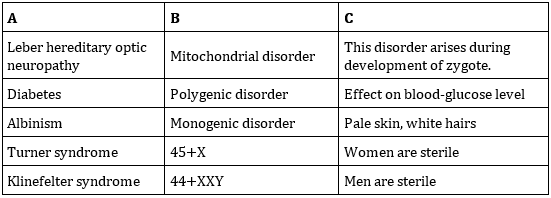
Solution 6
a. 44+X : Turner syndrome : : 44+XXY : Klinefelter syndrome
b. 3:1 : Monohybrid : : 9:3:3:1 : Dihybrid
c. Women : Turner syndrome : : Men : Klinefelter syndrome
Solution 7
